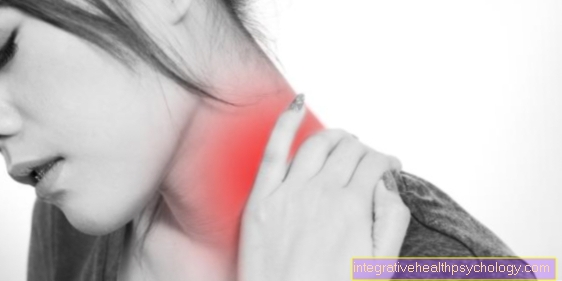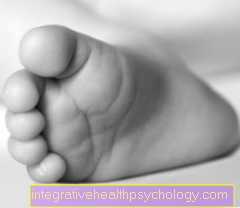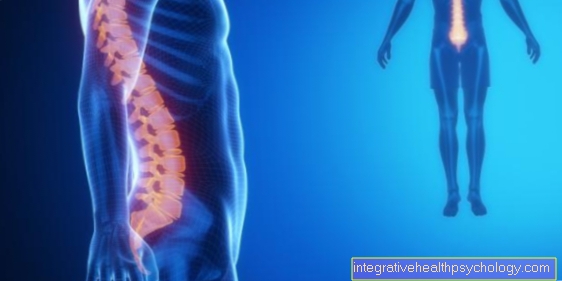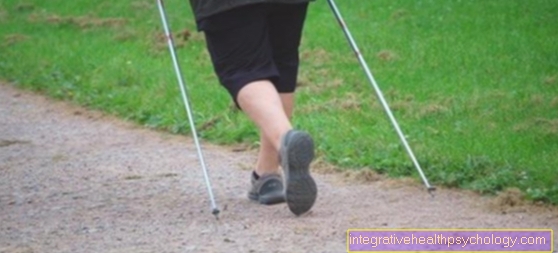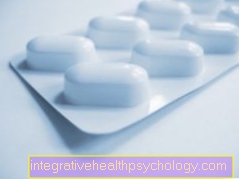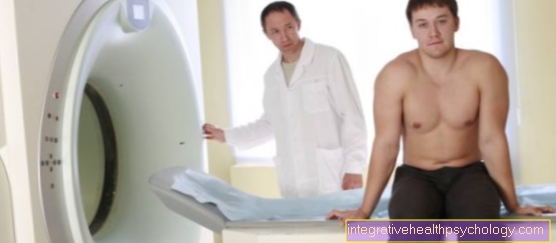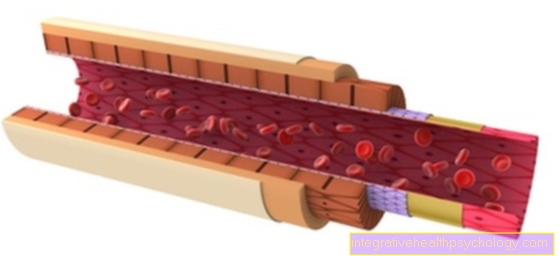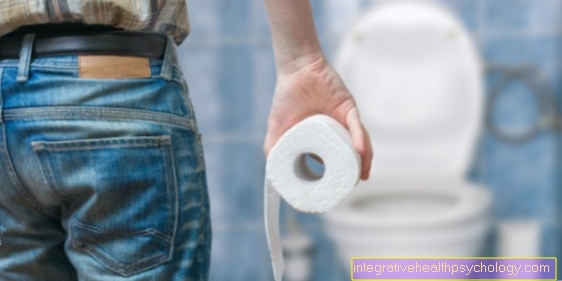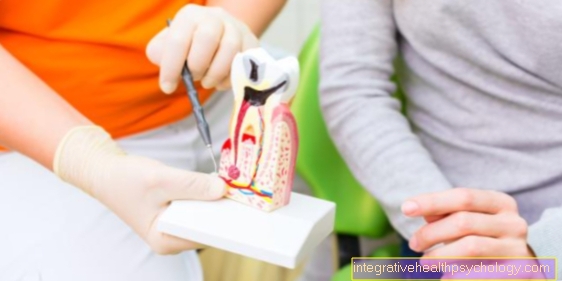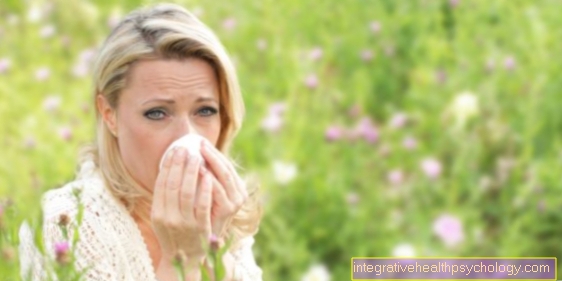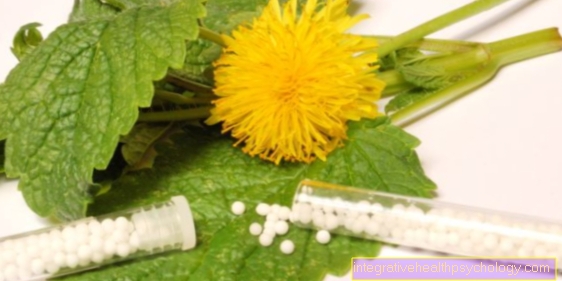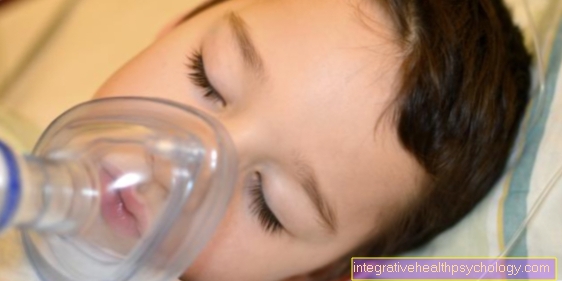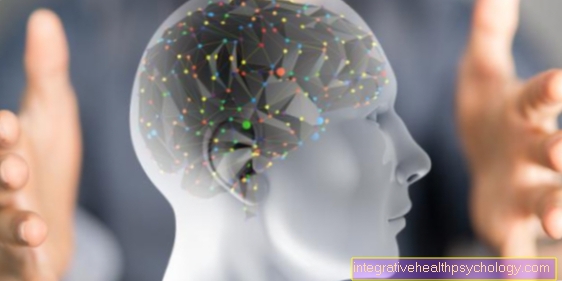Anti-anxiety medication
introduction
There are various drugs against anxiety, which are also known as psychotropic drugs, as they are drugs (pharmaceuticals) that treat the psyche, i.e. the thoughts and in this special case the fear.
In addition to these classic drugs against anxiety, there are also various alternative drugs that are natural.
It is also possible that a drug against anxiety and depression works in one and can therefore be used in patients who suffer from several mental illnesses.
Anti-anxiety medication can only be taken if you have spoken to a psychologist or psychiatrist beforehand, as psychotropic drugs are medications with sometimes high side effects.
Furthermore, the drugs against anxiety presented here are prescription drugs that can only be purchased in pharmacies upon presentation of a prescription.

Benzodizepine group of active substances
The benzodiazepines are a group of active substances, i.e. an upper group of drugs against anxiety. Benzodiazepines have several effects.
On the one hand, they take away the patient's fear, but on the other hand they also promote sleep and help the patient to relax. In addition to muscle relaxation (Relaxation) they also lead to increased tiredness (Sedation).
When taking benzodiazepines, a habitual effect occurs after a short time. The body then needs higher doses of the drug to achieve the desired anti-anxiety effect.
When taking benzodiazepines, there is always the risk that the patient will develop an addiction. In contrast to other drugs, the risk of developing addiction is relatively high with benzodiazepines. This is also the reason why benzodiazepines are only taken for a short period of time and the intake should be closely monitored by a psychiatrist. Furthermore, the different active ingredients of the benzodiazepines differ slightly from one another, with some being better used as anti-anxiety medication and others worse, as they promote sleep more or lead to muscle relaxation.
Read more on the topic: Drug addiction
Active ingredient diazepam
With the active ingredient Diazepam is an anti-anxiety drug that belongs to the benzodiazepine group of drugs. Thus, Diazepam is a Psychotropic drug, i.e. a drug against anxiety, sleep disorders, agitation or against withdrawal symptoms during alcohol withdrawal.
Diazepam is also often used in hospitals before operations or used before various diagnostic procedures. This is to calm down and take some of the patient's fear away. Diazepam is an effective ingredient that can be found in various anti-anxiety medications, as it ensures that the Transmission of fear via the nerve cells prevented becomes. Thus the information that the patient is feeling fear at this moment is not passed on to the brain and the patient no longer perceives the fear.
Most of the time, the patients take anti-anxiety medication with the active ingredient diazepam in the form of Tablets to himself. However, there is also the option of injecting diazepam into the muscle or as a Suppository in the buttocks to be introduced so that the active ingredient is released there and through the mucous membrane (Mucosa) of the anus gets into the blood and thus into the brain.
In the hospital, the anti-anxiety drug with the active ingredient diazepam is often given via the vein. This means that the drug is given as a liquid via a plastic tube directly into the superficial blood vessels and thus acts very quickly and can also be influenced very well.
Diazepam can also be given to children who have febrile convulsions. However, this should always be done under medical supervision.
Active ingredient oxazepam
With the active ingredient Oxazepam is an active ingredient from the group of Benzodiazepinesfound in anti-anxiety medication. The active ingredient oxazepam ensures that the Patient calmer which is why the active ingredient is also used as a sedative (sedative = calming). Thus, the active ingredient oxazepam can be contained in drugs against anxiety or against sleep disorders or depression. The effect is very similar to that of diazepam, but oxazepam works a little slower but also much longer. Oxazepam is used exclusively in the form of an active ingredient in anti-anxiety drugs Capsules respectively Tablets taken.
Active ingredient bromazepam
The active ingredient bromazepam is a substance contained in various anti-anxiety medications. Bromazepam is one of the so-called benzodiazepines and is usually called Anxiety drug administered. However, bromazepam can also be used when patients have difficulty sleeping. Bromazepam can also help patients to calm down when they are in a state of restlessness or tension. Bromazepam, like most bezodiazepines, is used in Form of tablets taken.
Active ingredient lorazepam
The active substance Lorazepam also belongs to the benzodiazepines and is a Anxiety drug. The active ingredient lorazepam can also be used in the case of very strong anxiety up to panic attacks, as this is a long-lasting drug that lasts the entire day. In addition to the classic tablet form, Lorazepam can also be administered in the hospital via the vein (intravenous) or in the muscle (intramuscular) can be administered. Depending on the dosage, Lorazepam can also be given for mild or moderate difficulty falling asleep. It can also be used for withdrawal, in epilepsy, as an anti-anxiety drug (Anxyolytic) for cardiac arrhythmias or as a drug before an operation (premedication).
Selective Serotonin Reuptake Inhibitors
Both Selective Serotonin Reuptake Inhibitors (SSRIs for short) are a large group of active substances that contain drugs for anxiety and drugs for depression.
The mechanism of action of these drugs is very complex and not very easy to understand.
With the molecule Serotonin is it a messenger substance (Neurotransmitters), which ensures that the patient feels good. If there is a lack of serotonin, the patient does not have enough messenger substances that contribute to a positive mood. It now happens that the patient becomes unhappy due to the lack of serotonin or feels very anxious.
To counteract the negative mood, there are the selective serotonin reuptake inhibitors, which as Anxiety drug and as Drug for sadness (Antidepressants) can be used. The selective serotonin reuptake inhibitors prevent the messenger substance serotonin from being removed from the blood and from the so-called synaptic gap. As a result, more serotonin remains and the patient's mood is brightened. At the same time, these drugs can be used against anxiety, as they can also help the patient to become more relaxed and thus minimize anxiety.
Active ingredient duloxetine
Duloxetine is an active ingredient found in various anti-anxiety medications. However, duloxetine is not just used as a Anxiety drug but also ensures that the patient feels less pain.
This is due to the fact that duloxetine allows the transport substances (neurotransmitters) noradrenaline and serotonin to have an increased effect by not removing them from the blood (hence the medical name: selective serotonin and noradrenaline - reuptake inhibitors).
As it is with Serotonin and Norepinephrine When it comes to substances that make the patient happy when they occur in high concentrations in the blood, duloxetine also improves mood and is therefore an effective drug against anxiety. The active ingredient duloxetine is usually administered in capsule form.
Active ingredient citalopram / escitalopram
With the active ingredient Citalopram or escitalopram is what is known as Serotonin Reuptake Inhibitors. These are used so that serotonin, a messenger substance (neurotransmitter) that makes you happy, remains in the blood. The active ingredient citalopram is found in anti-anxiety drugs, but it is also very often used as a drug for depression, i.e. as a Antidepressants, administered. Also with the patient Panic disorder, Phobias or Personality disorders Citalopram is used. In general, Citalopram works well as an anti-anxiety drug, as it has a mood-enhancing effect and increases vigor or drive. Citalopram is taken as a drug against anxiety in the form of tablets, whereby the exact dosage must be discussed with the treating psychiatrist and can be slightly increased or decreased as required.
Active ingredient paroxetine
The active substance Paroxetine can be found in various anti-anxiety drugs. Paroxetine is actually one of the drugs that are used against depression. More precisely, it is a so-called Serotonin reuptake inhibitor. This means that paroxetine prevents the transport molecules (neurotransmitters) serotonin from being removed, so that more serotonin can become active. This then makes the patient feel better because serotonin is a messenger that affects mood. Commonly used is paroxetine only rarely used as an anti-anxiety drug used, the active ingredient is more often used in one depression. But also with social anxiety disorders, with phobias or post-traumatic stress disorder Paroxetine can be used.
Tricyclic antidepressants
With the so-called tricyclic antidepressants it is a group of active substances that is mainly used against depression, but in some cases it is also used as a drug against anxiety. They ensure that messenger substances like Serotonin, Nor adrenaline and Acetylcholine remain in the blood. These substances should increase the patient's drive, they should also have a mood-enhancing effect and lead to a reduction in anxiety.
Tricyclic antidepressants are rarely used as a drug against anxiety and are also used less and less in patients with depression, as they have a very general and rather unspecific effect, which manifests itself in their wide range of side effects.
Active ingredient doxepin
The active substance Doxepin is often in Drugs for anxiety contain. It also has a mood-enhancing effect and not only helps against anxiety but also against depression. Actually, Doxepin is an active ingredient from the group of active ingredients tricyclic antidepressants, i.e. drugs that are primarily used against depression. However, the active ingredient doxepin can also be found in anti-anxiety medication, although it is a somewhat older active ingredient that is no longer prescribed as often. Doxepin can also be used for alcohol, drug or medication addiction, for chronic pain, bipolar disorders or sleep disorders.
Medication for anxiety during pregnancy

In general, Medication in Pregnancy should only be taken under very strict guidelines and only in close consultation with the doctor treating you, as most medications have not been tested to determine whether and, if so, to what extent they could harm the unborn child. Therefore, anti-anxiety medication is reluctant to use during pregnancy. However, in some patients it may be necessary to administer anti-anxiety medication during pregnancy, otherwise the patient would not be able to get through the pregnancy.
To the Anti-anxiety medicationthat are in the Never taken during pregnancy include benzodiazepines. Since this is the unborn Harm child under no circumstances should they be used during pregnancy.
The situation is different with the selective serotonin reuptake inhibitors out. These can, after more precisely Consultation with the treating psychiatrist be given as medication against anxiety during pregnancy, without the patient endangering the unborn child or causing serious malformations.
Tricyclic antidepressants should be used during pregnancy whenever possible not used because these anti-anxiety drugs have not yet been adequately researched and it is therefore unclear whether the unborn child could be harmed.
Drugs for anxiety in children
A child suffers from particularly bad fearsthat cannot be overcome by therapy alone, the administration of an anti-anxiety medication is an option.
In general, anti-anxiety drugs should not be used in children unless it is absolutely necessary, as there is no understanding of how the drugs affect the child's immature brain. So before you use anti-anxiety medication in children, you should use all other means of help, such as psychotherapeutic conversations or various psychological methods of coping with fear may be exhausted.
However, if psychological discussions are not enough, the child can be helped first with alternative medication against anxiety. Psychotropic drugs, on the other hand, should remain the last resort and should only be used as anti-anxiety medication in children who suffer from very severe anxiety disorders. In general, the duration is the application then mostly on 4-6 weeks limited to minimize side effects and interactions.
Drugs for anxiety and depression
Some drugs against fear also work against depressions and thus both diseases can often be treated with the administration of a drug. The so-called tricyclic antidepressants are drugs that were originally used against depression, but also against anxiety.
Also other above-mentioned groups of active substances such as Serotonin Reuptake Inhibitors are used as a drug for anxiety and depression because the drug generally lifts mood, which is desirable for both depression and anxiety patients.
In the active ingredient group of Benzodiazepines These are drugs that are mostly only used in patients with anxiety, but the drug is also used in depressed patients, especially if the depressed patient is under sleep disorders suffers. Thus, the benzodiazepine group of active ingredients also serves as drugs against anxiety and depression.
Medication for anxiety and restlessness
Most of the drug groups that are used in people with anxiety are Medication for anxiety and restlessness.
Most patients who are very anxious and who have what is known as an anxiety disorder also experience anxiety and tension.
Almost all of the groups of active ingredients already mentioned work as drugs against anxiety and restlessness, but these are the best Benzodiazepines. These have the property of having a calming effect. This can result in the patient becoming easily tired throughout the day, which some people find uncomfortable. Nevertheless, this group of active ingredients offers the best medicines for anxiety and restlessness.
Medication for anxiety and panic attacks
Some patients who suffer from anxiety disorders also have Panic attacks. Therefore, there are different drugs that can be used for both anxiety and panic attacks. The active substance group of benzodizepines is used particularly frequently, as they help to relax and thus relieve anxiety and panic.
Since a panic attack always comes with additional physical symptoms, such as a faster heartbeat (Tachycardia) or increased sweating, some sufferers also get so-called beta blockers prescribed. These drugs do not work directly against anxiety or panic attacks, but they ensure that the patient's heartbeat does not get too fast during a panic attack and that other physical symptoms, such as increased sweating or shortness of breath, are reduced.
Also other antidepressants, such as Serotonin Reuptake Inhibitors or tricyclic antidepressants, can be used as medicines for anxiety and panic disorders. However, since these are slow-acting medications, the effect of which only starts sufficiently after about 2 weeks, they are unsuitable for an acute panic attack.
As Emergency medication at a acute panic disorder drugs come with an active ingredient like Lorazepam in question which belong to the benzodiazepines.
Side effects
Like most other drugs, have Medication for anxiety side effectsthat are of different sizes and, above all, can occur very differently in each patient.
The benzodiazepines, which can be found as an active ingredient group in anti-anxiety drugs, sometimes have the strongest side effects.
With these anti-anxiety drugs, side effects such as difficulty breathing, reduced ability to react, increased fatigue and, above all, a high potential for addiction occur. The latter means that patients can become dependent on these drugs, similar to drugs, nicotine, or alcohol.
The active ingredient group of the Serotonin reuptake inhibitors Contains anti-anxiety medication with side effects, which can vary greatly depending on the drug used. Here it mainly comes to Digestive problems, a headache (Cephalgia), a decreased sexual pleasure (decreased libido) to the inability to get an erection (erectile dysfunction), nausea, sleep disorders and restlessness.
Both tricyclic antidepressants It is an anti-anxiety medication with side effects that can sometimes be so pronounced that they are rarely recommended today. Sometimes it comes to one sfaster heartbeat (Tachycardia), to Dry mouth, to a decreased ability to urinate, to a decreased heart function, to Visual disturbances and to Constipation.
Anti-anxiety drugs are not always associated with side effects. However, since these are very powerful psychotropic drugs, i.e. drugs that affect the psyche of people, side effects are almost always to be expected when used. How strong these are and how well the patient copes with them, however, varies greatly from patient to patient.




